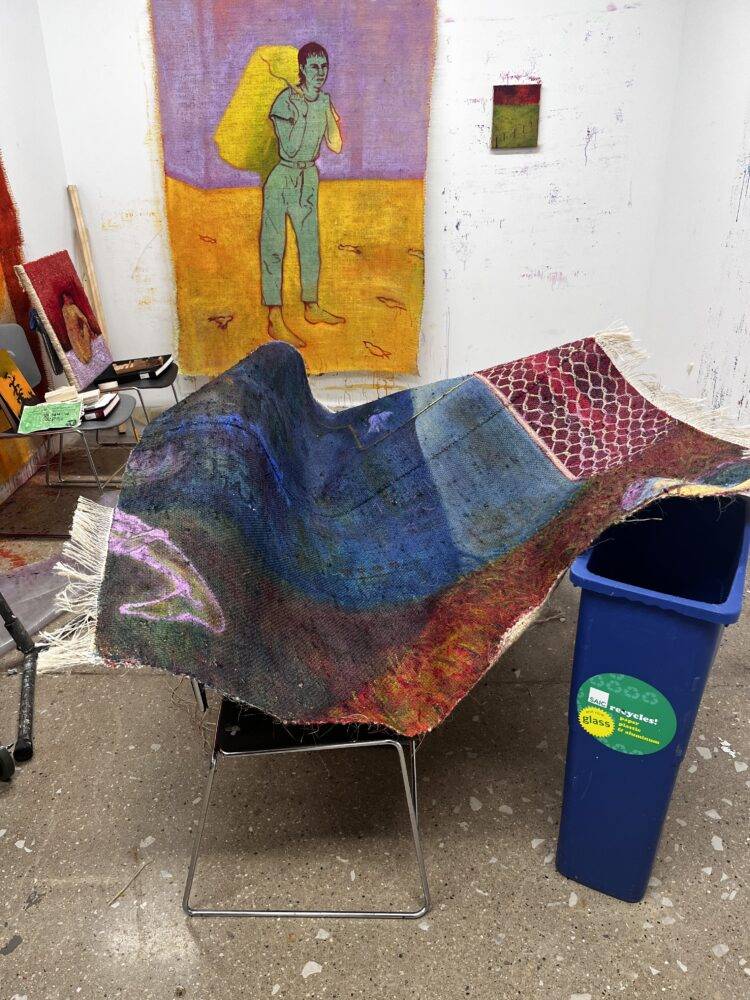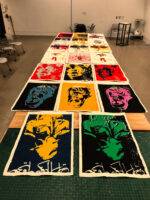Virginia Kennard (MFA Performance 2025) was attending winter classes at Ox-Bow School of Art & Artists’ Residency this January when she received an email notifying her of the flooding at SAIC Galleries 33 E. Washington St., where her studio is located.
“There has been a water pipe burst in the building. The building is closed until further notice,” read the Jan. 18 email. Upon returning to Chicago, Kennard found herself without a space to accommodate her artwork and art material she was bringing back from Ox-Bow in Michigan.
Sam Tripodi (MFA Photography 2024), Kennard’s studio neighbor, was affected by a similar, albeit smaller, flood in the same building around the same time last year.
“A pipe broke in the building and caused the flood, but no one had to move out, except me and the person next to me because there was mold in the walls,” said Tripodi, recalling the incident. Although the first flood had minimal impact, Tripodi lost a significant portion of her displayed work. But she believes that the school learned to respond quickly. “I don’t know if they had strategies after the first one, but I’m guessing they kind of knew.”
When Tripodi was notified of the new flood, she panicked.
“We were shocked that they weren’t letting us come and take our work away, or telling us which studios had been affected,” she said. Her concern grew as she feared that the work was further deteriorating by sitting in water. However, for the next four to five days, there was no update from the school. “So it was like, have I lost all my work? What am I supposed to do with myself,” Tripodi said.
The lack of communication from the school left artists uncertain about the fate of their work. “Losing three weeks of time right now is terrible, when some of us have a show coming up in less than a month,” Tripodi said.
The following week, students received emails stating that the damaged items and potential mold hazards had been eradicated. Now they could return to their studios.
“I had said to myself I’m not worried about losing work like other people,” Kennard said. As a performance major who works primarily with body, she didn’t have specific artwork stored in her studio. So far, she’d been appreciative of the work the Academic Studio Operations had been doing.
Her gratitude was short-lived. “When I returned to my studio ten days later, I said to myself, ‘Ah, actually, that’s not the case. There might be some more damage,’” she said. Kennard found a box with her books molding inside, some of which were checkouts from Flaxman Library.
Nevertheless, Kennard considers herself fortunate in the incident. “I feel lucky, because I didn’t really lose any work. I’m thinking about other people. It is heartbreaking to have your work ruined right before an exhibition goes up,” Kennard said.
Kyle Gregory Prince (MFA Performance 2025) echoed Kennard’s sentiment, expressing empathy for those who suffered bigger losses. “An old sewing machine in my studio got damaged, but I had nothing on the walls. I immediately knew there wasn’t any risk of losing artwork,” Prince said. “My heart immediately went out to those who lost work,” he added.
For Painting and Drawing student Pedro Montilla (MFA 2025), the impact was profound. The pipe that burst was above his ceiling, resulting in heavy pressure water flowing directly into his studio.
“I had a big painting that got very damaged,” he said. “And I had brought fabric from my country [Colombia] to work with, and it also got damaged.”
Montilla paused when asked if the school handled the situation well. “I think the school has tried, but they have been a little sloppy. They have made some mistakes,” Montilla said.
He believes some of the work was salvageable. “I was going to show this painting in an exhibition in Colombia, but the work is now damaged. When I arrived here, the painting was warped between chairs,” he said.
Montilla’s material was discarded while the building was still shut. “I didn’t even get to see it, though I understand they had to throw it to prevent mold from spreading,” he said.
For now, Montilla is left without any material to work with, giving his studio a deserted look.
Tripodi too, returned to her studio to find her work mishandled. Although she was able to return to work immediately she is disappointed. “Maybe if we had been allowed to come in, we would have not lost our work,” she said.
“There has been damage that I can’t undo,” Kaiden Su (MFA 2024, Painting and Drawing) said, acknowledging the challenge of moving forward from the incident. While grappling with the aftermath he refrained from elaborating further. “I guess one thing I would say is that I hope that the school will consider implementing additional safety measures and not allow this to happen again in the future,” he said.
The school has extended some material support, but it’s limited.
“We have been sent reimbursement. We are supposed to do all the work and get receipts of the material, and wait for them to verify the documents and send the reimbursement,” Kennard said.
Tripodi, pointing at one of her drawings saved, said, “For a drawing like this, they would reimburse me $3 for the cost of the paper, what about the hours and hours of work I did on it?”
Montilla — who is waiting for his material to be shipped from Colombia — expressed hope. “The email said they will reimburse me for the material and I’m waiting for that to happen so I can resume my practice,” he said.
In response to the challenges posed by the flooding, SAIC’s Academic Studio Operations emphasized the paramount importance of safety. “Safety was our biggest concern, and given the risk of electrocution and the shutdown of all elevators, security systems, and fire suppression systems due to the flooding, it would have been irresponsible to let students in right away,” Thomas C. Buechele, Vice President for Facilities & Campus Operations, said.
Acknowledging the severity of the situation, Buechele highlighted the thorough measures that were taken to ensure a safe environment for students, including the removal of water, restoration of security systems, and re-establishment of communication channels. Within less than a week of the flooding, students were permitted to enter the building safely to retrieve items from their studios, and within 15 days, full access was restored.
Explaining the circumstances surrounding the burst pipe, noted, “The pipe that burst was original to the building and was located within the floor above our spaces.” Despite regular inspections and the use of thermal cameras to detect potential issues, extreme weather conditions presented unforeseen challenges. Buechele underscored the proactive response taken in such situations, saying, “In the case of extremely frigid weather like we had right before the pipe burst, unfortunately, this type of situation is common in any building—commercial or residential, old or new—so often the best we can do is respond quickly and decisively, which we did here.”


















